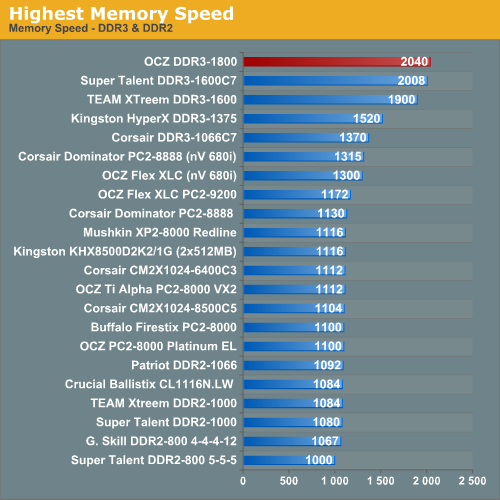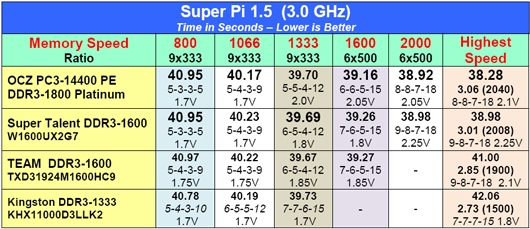Overclocking
We were more than surprised when Super Talent DDR3-1600 topped our overclock charts at DDR3-2008 in our last DDR3 memory review. The OCZ DDR3-1800 is based on a different binning of the same Micron Z9 memory chips, and it achieved an even faster overclock at a stable DDR3-2040.

Perhaps even more significant were the timings that could be achieved at DDR3-2040. OCZ rates this memory at 8-8-8-27 timings at DDR3-1800. At 2040 the timings of 8-8-8-21 provided stable performance with 2.1V. This compares to the Super Talent, which is also based on Micron Z9, which required slightly slower 9-8-7-18 timings at 2.25V to achieve a stable DDR3-2008. The slightly better timings with the OCZ memory suggests that OCZ is using more aggressive speed binning for their new DDR3-1800 parts than others are using for their DDR3-1600 parts.
Advances in memory technology are rarely as dramatic as the speed and timing improvements we are seeing recently with Micron Z9 memory chips. For reference we included our ongoing overclocking chart results for DDR2 just so you can see how significant the new Micron Z9 memory really is. The highest DDR2 we have tested is Corsair memory at 1315 in an EVGA 680i motherboard. Early DDR3-1066 reached a bit higher as in the typical 1370 achieved with the launch Corsair DDR3-1066. Timings, however, were somewhat slow. Then the Kingston HyperX pushed 7-7-7 timings all the way to DDR3-1500. Now, less than 2 months later, state-of-the-art DDR3 is reaching DDR3-2000+ at aggressive timings. This kind of progress in memory technology makes the original JEDEC target of 800 to 1600 for DDR3 speeds appear far too limited.
Some end users consider 7-7-7 timings a benchmark with DDR3. We set those timings and pushed the OCZ as far as possible. The DDR3-1800 reached DDR3-1900 at 7-7-7-timings at 2.1V. This incredible speed at 7-7-7 eclipses previous results at 7-7-7 timings. The OCZ, Super Talent, and TEAM results are close at all comparable speeds, but the OCZ manages slightly better performance, slightly tighter timings, and a higher overclock than the other two Z9-based kits. OCZ is apparently binning to slightly tighter tolerances than the other two memories and that is showing in the performance improvements.
Super Pi
In Kingston Launches Low-Latency DDR3 memory performance was compared at 800, 1066, 1333, and highest memory speed. With the introduction of higher speed DDR3 we have added 1600 and 2000 to the standard comparison speeds, if the DDR3 memory is capable of reaching that speed.
To look at pure number crunching, Super Pi 1.5 was run in all memory test configurations. Super Pi is a very simple program as it merely calculates the value of Pi to a designated number of decimal positions. In this case we chose 2 million places.
Super Pi is fastest (lower value for calc time) on the OCZ DDR3-1800 and Super Talent memory. Both these memories are based on the new Z9 Micron memory chips. At 1333, the Kingston is close behind, but it tops out at around 1500 speed, while the top Z9 memories go on to 2000 speed - shaving another 1.4 seconds off the Super Pi time at the same CPU speed. Lower latency DDR3 now passes DDR2, on either the P35 or P965 platforms, and extends to new performance levels. Any speed above 1066 is the domain of DDR3 and the higher speed delivers improved performance.
It is interesting that by 1333 the lower latency DDR3 has completely closed any gap that existed with the fastest timing DDR2, which can run as fast as 3-3-3 timings at moderate memory clocks. Lower latency DDR3 clearly demonstrates you will not have to give up a thing with DDR3 in the overlap speeds and you will gain higher speeds as well. The only current roadblock to DDR3 is the high price of admission.
We were more than surprised when Super Talent DDR3-1600 topped our overclock charts at DDR3-2008 in our last DDR3 memory review. The OCZ DDR3-1800 is based on a different binning of the same Micron Z9 memory chips, and it achieved an even faster overclock at a stable DDR3-2040.

Perhaps even more significant were the timings that could be achieved at DDR3-2040. OCZ rates this memory at 8-8-8-27 timings at DDR3-1800. At 2040 the timings of 8-8-8-21 provided stable performance with 2.1V. This compares to the Super Talent, which is also based on Micron Z9, which required slightly slower 9-8-7-18 timings at 2.25V to achieve a stable DDR3-2008. The slightly better timings with the OCZ memory suggests that OCZ is using more aggressive speed binning for their new DDR3-1800 parts than others are using for their DDR3-1600 parts.
Advances in memory technology are rarely as dramatic as the speed and timing improvements we are seeing recently with Micron Z9 memory chips. For reference we included our ongoing overclocking chart results for DDR2 just so you can see how significant the new Micron Z9 memory really is. The highest DDR2 we have tested is Corsair memory at 1315 in an EVGA 680i motherboard. Early DDR3-1066 reached a bit higher as in the typical 1370 achieved with the launch Corsair DDR3-1066. Timings, however, were somewhat slow. Then the Kingston HyperX pushed 7-7-7 timings all the way to DDR3-1500. Now, less than 2 months later, state-of-the-art DDR3 is reaching DDR3-2000+ at aggressive timings. This kind of progress in memory technology makes the original JEDEC target of 800 to 1600 for DDR3 speeds appear far too limited.
Some end users consider 7-7-7 timings a benchmark with DDR3. We set those timings and pushed the OCZ as far as possible. The DDR3-1800 reached DDR3-1900 at 7-7-7-timings at 2.1V. This incredible speed at 7-7-7 eclipses previous results at 7-7-7 timings. The OCZ, Super Talent, and TEAM results are close at all comparable speeds, but the OCZ manages slightly better performance, slightly tighter timings, and a higher overclock than the other two Z9-based kits. OCZ is apparently binning to slightly tighter tolerances than the other two memories and that is showing in the performance improvements.
Super Pi
In Kingston Launches Low-Latency DDR3 memory performance was compared at 800, 1066, 1333, and highest memory speed. With the introduction of higher speed DDR3 we have added 1600 and 2000 to the standard comparison speeds, if the DDR3 memory is capable of reaching that speed.
To look at pure number crunching, Super Pi 1.5 was run in all memory test configurations. Super Pi is a very simple program as it merely calculates the value of Pi to a designated number of decimal positions. In this case we chose 2 million places.
 |
| Click to enlarge |
Super Pi is fastest (lower value for calc time) on the OCZ DDR3-1800 and Super Talent memory. Both these memories are based on the new Z9 Micron memory chips. At 1333, the Kingston is close behind, but it tops out at around 1500 speed, while the top Z9 memories go on to 2000 speed - shaving another 1.4 seconds off the Super Pi time at the same CPU speed. Lower latency DDR3 now passes DDR2, on either the P35 or P965 platforms, and extends to new performance levels. Any speed above 1066 is the domain of DDR3 and the higher speed delivers improved performance.
It is interesting that by 1333 the lower latency DDR3 has completely closed any gap that existed with the fastest timing DDR2, which can run as fast as 3-3-3 timings at moderate memory clocks. Lower latency DDR3 clearly demonstrates you will not have to give up a thing with DDR3 in the overlap speeds and you will gain higher speeds as well. The only current roadblock to DDR3 is the high price of admission.










25 Comments
View All Comments
Lonyo - Tuesday, July 31, 2007 - link
Any chances of a power consumption comparison between DDR2 and DDR3?DDR3 is supposed to run at a lower voltage, so in theory it might use a little less power. Would be interesting to see if there is any difference (DDR2/3-800 would probably be best, since that's a standard speed for both).
yyrkoon - Tuesday, July 31, 2007 - link
Does anyone even sell a DDR3 capable motherboard yet ? If so, is anyone even using DDR3 ? Personally, I think latencies need to come down, Prices need to come down,etc. Memory companies are *claiming* they are taking a beating in the market for DDR2 (claiming all time low, and losing money . . .).Personally, I think you reap what you soe, and they got what they deserved for their early market prices.Anyhow, short and skinny, I think *we* all need to take things slowly this time around, OEMS, buyers, and reviewers . . .
yyrkoon - Tuesday, July 31, 2007 - link
By the way, when I asked if anyone is even making a DDR3 motherboard yet, I was pretty much joking. Obviously if you're testing it, there has to be some form of a platform availible.You know, I cannot help but think that DDR2 was not quite 'finished' yet, and I do not understand the *need* for DDR3(unless OEMs are looking to rape our wallets again . . .). Of course, if 'Joe blow enthusiast' HAS to HAVE DDR3 memory because it gives him/her an extra 4-13 FPS in an outdated game at 2-3x the cost of DDR2 . . . well... lets just say that I expect that OCZ, Geil, and the rest would be more than happy to keep you poorer ;)
Some of us actually like to upgrade smart, using as many parts from older machines as possible to save money for other things. This sort of marketing strategy makes it hard on us who would like to do so while keeping our system upgraded once a year or so. I just got over having to buy memory, CPU, and a motherboard the last 'technolgy' advance, and I really do not wish to repeat the process.
asliarun - Tuesday, July 31, 2007 - link
Man, I never understand viewpoints such as yours. This is a technology article on the latest DDR3 advancement, and is not marketing propoganda urging you to go out and buy it NOW. Intel's latest CPU chipsets (P35/P38, IIRC) all support DDR3 (along with DDR2), so it's not like DDR3 is exactly vaporware. Only AMD is not supporting DDR3 right now because firstly, they will need to upgrade their integrated uncore memory controller, and secondly, they tend support upcoming technologies much later than Intel. Furthermore, DDR3 is definitely the future as it has much more headroom than DDR2, and is designed to work at lower voltages.In any case, my point is that we're discussing a new memory standard technology which is already in the market and is slowly being adopted. Initially, it WILL be highly priced like any other technology until volume manufacturing kicks in. However, if you are a price sensitive customer instead of a "Joe blow enthusiast" (frankly, like most of us), no one is forcing you to replace your RAM with DDR3 TODAY, least of all this AT article. Your logic of not adopting DDR3 simply because it is initially expensive and because it only gives "4-13fps increase" is however, absurd. By the same token, there is no need for ANY technology improvement, especially those that *only* result in an incremental improvement.
As a footnote, you should be grateful for all the "Joe blow enthusiasts" in this world instead of heaping scorn on them. All said and done, you and I ARE freeloading on him, as he's the one who's financing our cut rate technology purchases.
GlassHouse69 - Tuesday, July 31, 2007 - link
Oh you think so?hm.... i wonder how much Anandtech/daily got for reviewing this... hm.....